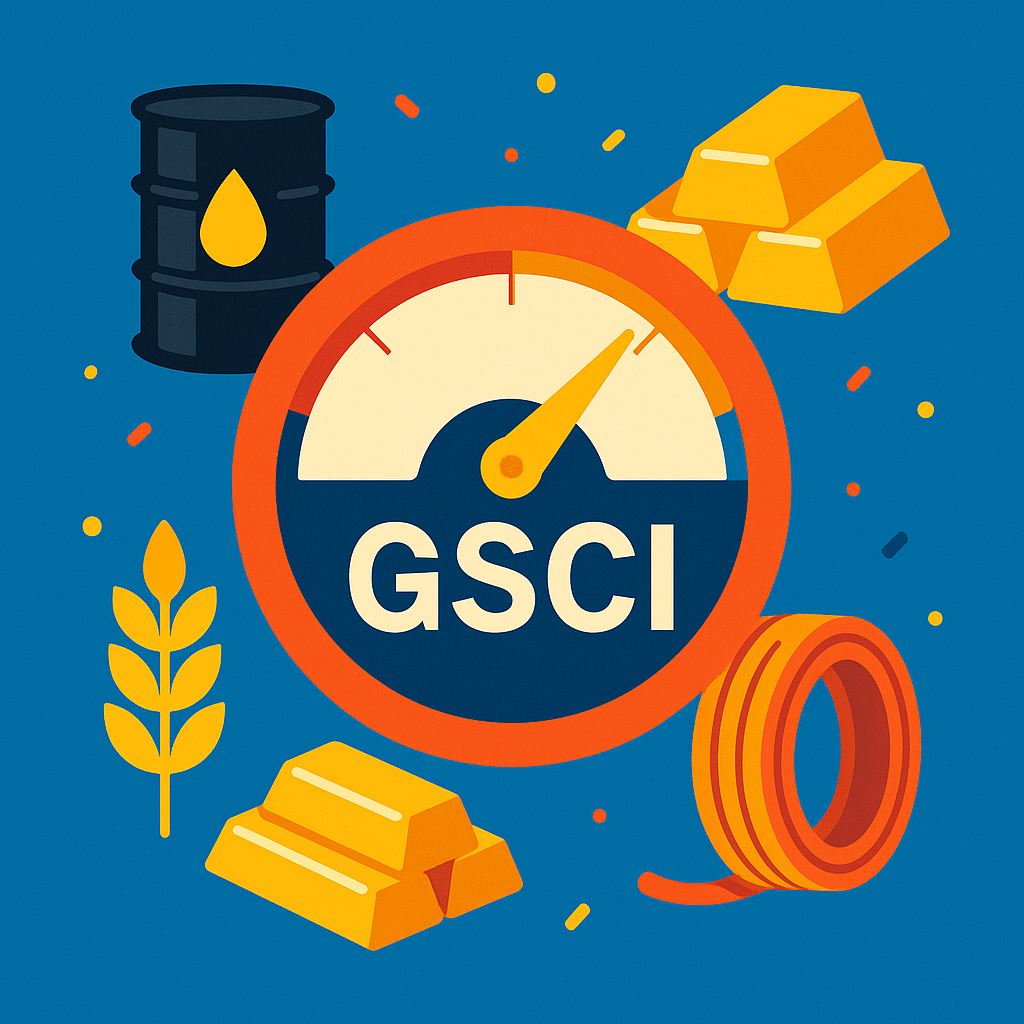S&P GSCI explained in depth—showing how the flagship production‑weighted commodities benchmark blends global energy, metals, and agriculture futures; why its energy tilt offers pure inflation beta; and what 2025’s target weights reveal about supply‑demand shifts.

1. What Is the S&P GSCI?
Launched in 1991, the S&P GSCI (formerly Goldman Sachs Commodity Index) is a tradable basket of 24 exchange‑listed commodity futures weighted by world production. Because output drives weights, the index mirrors the economic importance of each raw material, not liquidity. Consequently, energy dominates—historically 55–65 %—while metals and agriculture round out the balance.
2. How the Basket Is Constructed
Every February, S&P Dow Jones Indices updates production weights using five‑year averages supplied by agencies such as the IEA, USDA, and USGS. Caps are minimal: no sector ceiling, and single commodities may top 50 % if global output warrants. The index rolls futures monthly on fixed schedules—longer‑dated for energy, nearest contracts for grains—maintaining constant exposure without physical delivery.
3. 2025 Weight Snapshot
- Energy ≈ 58 % —WTI, Brent, RBOB gasoline, heating oil, gasoil, natural gas
- Industrial Metals ≈ 12 % —copper leads, followed by aluminum and zinc
- Precious Metals ≈ 7 % —gold and silver
- Agriculture & Livestock ≈ 23 % —wheat, corn, soybeans, coffee, live cattle
Thus, when oil spikes, the S&P GSCI outperforms more balanced peers like BCOM.
4. Why Allocators Use the GSCI
- High Inflation Sensitivity. Energy‑heavy weights amplify CPI hedging.
- Production Authenticity. Investors seeking “real economy” exposure prefer output‑based weighting.
- Deep Liquidity. Each constituent trades on major venues (CME, ICE, LME).
ETNs and swaps tracking the index enable turnkey access without rolling contracts.
5. Strengths & Limitations
| Strengths | Limitations |
|---|---|
| Mirrors global production, capturing macro demand | Energy weight near 60 % raises volatility |
| > 30 years of history informs asset‑allocation models | Roll yield drag can be severe in contango |
| Simple, rules‑based calculation | Minimal caps under‑represent transition metals like lithium |
6. Comparison With Bloomberg BCOM
Whereas BCOM caps sectors at 33 % and single commodities at 15 %, the S&P GSCI explained here allows production to dictate sizing. Accordingly, GSCI is more volatile but also more responsive to oil shocks. Smart‑roll or factor‑tilted variants (e.g., GSCI Dynamic Roll) aim to soften carry costs while preserving production logic.
7. What Lies Ahead
Energy transition could shrink oil’s share below 50 % by 2030, boosting copper and nickel. S&P DJI is studying low‑carbon and ex‑energy versions of the GSCI, signalling that ESG overlays will soon accompany the classic benchmark.
Key Takeaways
- S&P GSCI explained: a 24‑futures, production‑weighted index dominated by energy.
- Annual resets and monthly rolls keep exposure current yet roll costs visible.
- Investors use GSCI for high‑beta inflation hedges, accepting greater volatility than balanced peers.